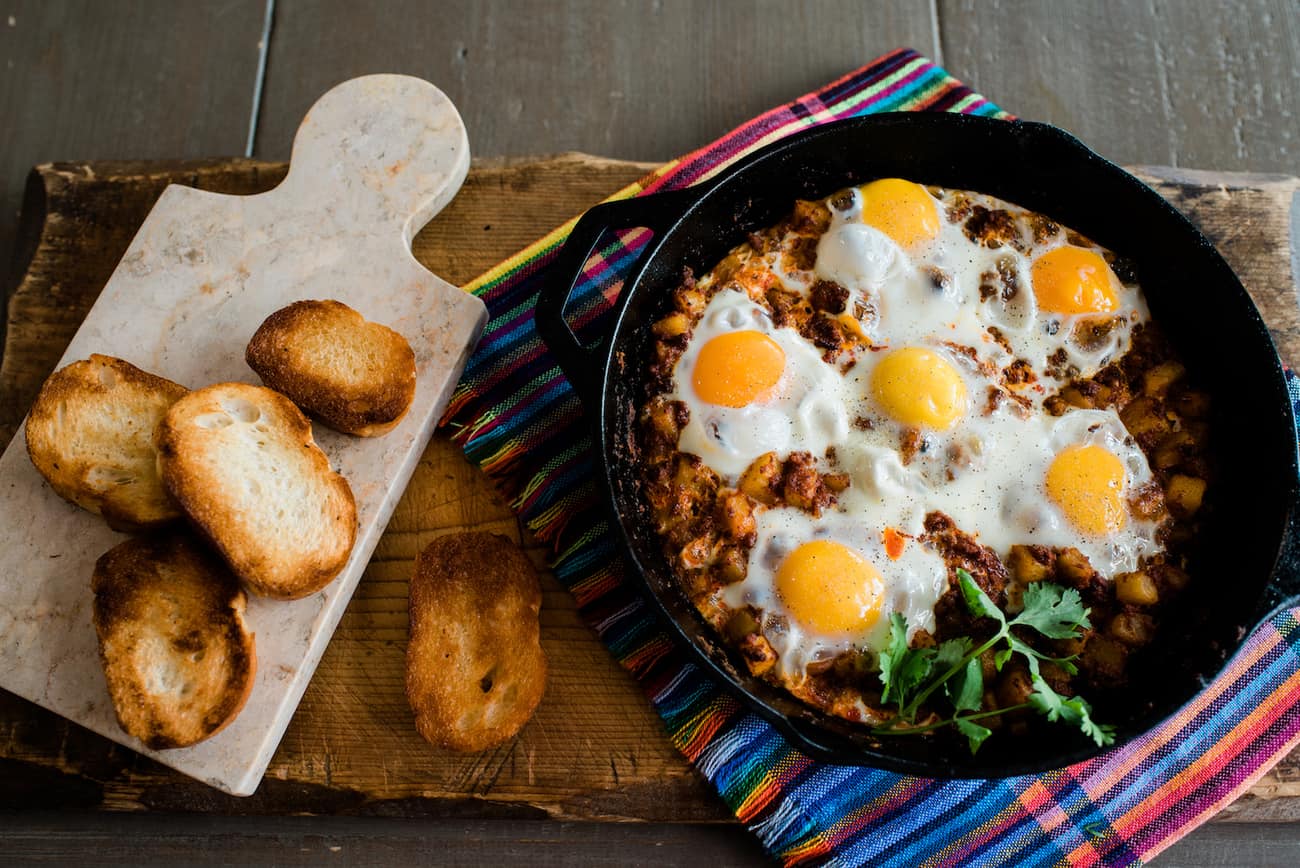How To Clean A Cast Iron Skillet
Between baking, making tortillas, searing meat and veggies, and being a handy grilling tool, my cast iron cookware gets a lot of mileage in the kitchen. Knowing how to properly care for and clean a cast-iron skillet is an essential skill every home cook should learn!
Oh, and before you go running off, three generations of my family have determined that using soap is just fine. Read on and learn more about how easy it is to keep your cast iron in tip-top shape!

Cleaning Equipment Needed
Cleaning your cast-iron skillet only requires a few basic pieces of cleaning equipment:
- Course Salt – To remove stubborn bits of food, pour coarse kosher salt into the still-warm skillet and scrub with a sponge.
- Sponge – Usually, this is enough to do the trick with some warm water and a dab of dish soap. Make sure you’re not using super abrasive cleaners like steel wool or metal brushes. I’m a huge fan of Scrub Daddy Sponges.
- Warm (or Hot) Water – It is best to clean the cast iron promptly after use, so be sure to use warm-hot water to clean it. If you change the temperature too rapidly, it can break, so avoid using cold water unless the pan has cooled first.
- Dish Soap – Even the revered cast-iron manufacturer Lodge says using soap is okay! The trick is to not use any abrasive cleaners here — keep the Bon Ami/Caulmet/abrasive powders and steel wool or metal scrapers on the no-no list.
- Hard Spatula (Optional) – You can buy a specific cast iron scraping tool that is about the size of a credit card and is made out of firm plastic, but check your kitchen first to see if you have anything else that could do the trick.
- Neutral Flavored, High-Smoke Point Oil – It honestly doesn’t matter which you use: vegetable, canola, peanut, grapeseed, avocado, shortening, or non-stick cooking spray. Just make sure to give it a good once over so the whole surface looks like you gave it a shine.

How To Clean Cast Iron Skillets
Learning to clean your cast-iron is super simple. Here’s how it’s done:
Step 1: Wash. Using warm or hot water, a small amount of dish soap, and a sturdy brush, clean the pan. If food is stuck, you can use course salt and scrub with a sponge. You can also simmer a bit of water for 3-5 minutes if food is really persistent.
Step 2: Dry. THIS IS OF UTMOST IMPORTANCE. Leaving your cast iron wet is like soaking your nails in acetone; it’ll totally ruin the surface. Unless cast iron has been coated in enamel, it is very susceptible to rust. Dry very thoroughly.
Step 3: Re-Season. Once your cast iron is bone dry, rub any neutral, high-smoke point oil into the surface using a clean towel. Keep rubbing it around until there is no visible residue. It should look like your furniture after you’ve cleaned it with wood polish.
Here’s a video showing just how easy it is to clean your cast iron cookware at home!
Expert Tips
- Make sure your cast-iron pans are properly seasoned before putting them to work. While keeping cast-iron skillets in good working condition isn’t hard, it’s important you prepare it before you start using it as the true kitchen workhorse it is.
- Clean expeditiously. Don’t leave your beautifully rugged cookware to languish in leftovers. It’s best to get your food on plates or put into containers and clean your cast iron as quickly as possible. Whatever you do, don’t under any circumstances let it soak!
- Don’t use cold water. If you are following best practices and cleaning while it is still warm, be sure to check that the water temperature is sufficiently warm before cleaning. If cast iron undergoes too quick of a temperature change, it can crack.
- Dry thoroughly. Rust is literal cancer for cast-iron. Take good care to ensure your babies are nice and dry before you put them away.
- Simmer for stuck on food. If you really went for it with that last round of searing and something doesn’t want to yield, you can’t soak the cast-iron or you may kill it with rust. Instead, place a few inches of water in the skillet over med-high heat and simmer for 3-5 minutes, using a cast iron brush or scraper to help if needed. From there, immediately dump the water, dry it, and re-season.

Frequently Asked Questions
Cast iron pots are heavy but worth the extra muscle it takes to use them. Plus, they are affordable and really durable—they can last for decades. Cast iron won’t dent, bend, or warp at high temperatures and can handle sharp kitchen utensils. They are also versatile, working on both the stovetop and in the oven.
Cast iron pans and dutch ovens can be used for frying and baking. When properly seasoned they are terrific for non-stick cooking on top of the stove as well as baking in the oven.
Black flecks on your towel in step 2 or 3 is totally normal, and is just part of the seasoning coming off. Just make sure you’re using cleaning towels you don’t mind getting a little stained up in the process, or opt for paper towels instead.
Yep! Contrary to popular opinion, using soap on cast iron is something my family has done for 3 generations, and many of those pots and pans are still in use today. Just make sure you’re using regular dish soap while hand washing, not any abrasive cleaners like Bon Ami or Cascade. Also, dishwashers are a big no-no.
If you do it properly, the big to-do of seasoning your skillet for the first time should only happen once. From then on, it’s all just maintenance. That said, you should be rubbing some oil into your cast iron after each and every use.
Duh! Where else would you store it? It’s a Hispanic joke actually. Its natural for Latinos to store dishes in the oven. And since I don’t have a lot of storage space — my favorite cast iron skillets are stored in the oven and my comal has a permanent spot on the stove. Just be sure not to accidentally preheat the oven with them inside, because you will slowly remove the cure.

Favorite Cast Iron
I have baked, seared, fried, in my cast iron pans and wanted to share my favorites with you:
- Cast iron fajita skillet
- Cast iron paella pan
- Comal (cast iron griddle)
- Cast iron grill pan
- Cast iron pre-seasoned skillet
- Small cast iron skillet
- Cast iron Dutch oven
Recipes to Make in Cast Iron
Make everything from tortillas, to fajitas, to cakes in this versatile, heat-retaining material.
More How-Tos
- How to Clean & Care for a Copper Sink
- How to Compost at Home
- Plant a Salsa Garden
- How to Keep Your Cutting Board from Slipping
Leave me a comment and tell me all about your favorite cast iron dish. If you don’t have one and want to buy one, check out all my favorite products on Amazon. For more awesome kitchen tips and delicious recipes, be sure to follow me on Instagram, Facebook and Pinterest!
 Muy Bueno: Fiestas
Muy Bueno: Fiestas 


4 Comments on “How To Clean A Cast Iron Skillet”
Looks like autocorrect got you. I think the salt should be coarse not course
Thank youuuu for sharing!
Un fuerte abrazo
Hola, I followed the ling to Scrub Daddy’s but found no information whether these scrubbers are recyclable material. Do you know? Thank you,
PS: love all your recipes and stories. Follow you and subscribe.
Laura Spiegel
Hola Laura! According to their website FAQs — they are not recyclable and test results are pending if they are biodegradable.